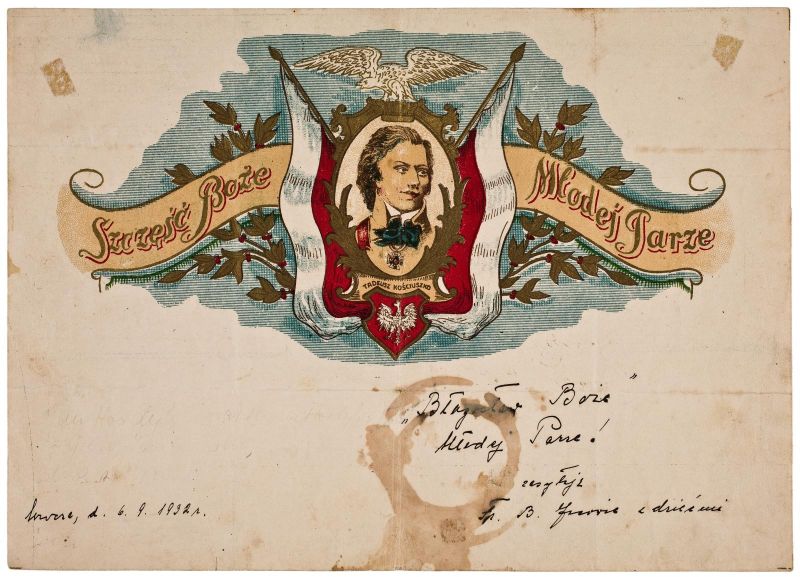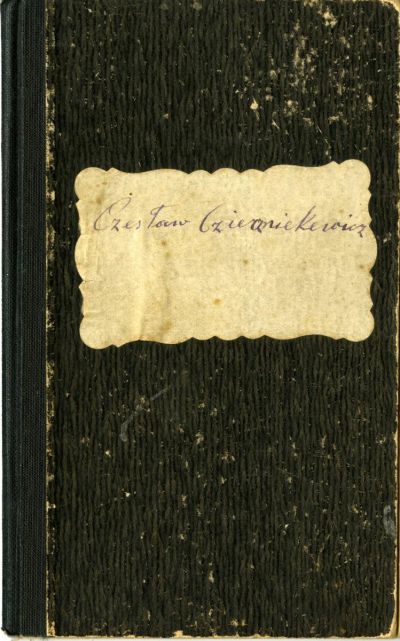“Faithful to the Fatherland, even in foreign lands”. Patriotic telegrams from the Polish diaspora in Wrocław
Mediathek Sorted












The second telegram that Jan Stache received for his name day is dated 24 June 1930 and contains messages of congratulations from the singing group “Harmonie”, from the Polish School Association and the Wrocław branch of the Union of Poles in Germany. The pre-printed telegram, which was issued by the Poznań Society of Public Libraries, shows a stylised portal in the middle of which can be see the silhouette of Poznań Town Hall and underneath, in the foreground, an open book and a burning oil lamp as symbols of education. This form is one of the most popular congratulatory telegrams issued by the Society of Public Libraries. The symbolism of the image relates to the idea of “organic work”, a term coined by Polish Positivists, for which the training and education of the masses was an important element in the fight to preserve the national identity.
Other telegrams in the Wrocław document gallery relate to the Hordyk family. Gabriela Marchwicka and Jan Hordyk were married in Wrocław on 3 February 1894.[18] Both were involved in Polish organisations: she worked at Towarzystwo Polek (Polish Women’s Association), whilst he was a shoemaker by profession and active in the Towarzystwo Przemysłowców Polskich (Association of Polnish Entrepreneurs) in Wrocław, which was largely made up of Polish craftsmen.[19] When the Polish State was reborn, the Hordyks left Wrocław for Gniezno in 1920.
The earliest telegram to members of the Hordyk family is from 1919 and was sent on the occasion of Gabriela and Jan’s silver wedding anniversary by the Association of Polish Entrepreneurs. Jan Hordyk was a long-term member of the Association and was also its managing director for some of that time.
On this copy can be found a portrait of Tadeusz Kościuszko and an eagle holding in its talons a laurel wreath with a red and white sash of the Association of Public Libraries, as well as the following quote from Kościuszko: “Wzbudzić potrzeba miłość kraju w tych, którzy dotąd nie wiedzieli nawet, że Ojczyznę mają” (The love for the land of their fathers is to be awoken in those who were not aware that they have a fatherland).
Four telegrams were addressed to Jan Hordyk and Gerta, née Zaremska, whose were married in Mrocza in Pommerania on 6 September 1932. It is assumed that the groom was the first-born son of Gabriela and Jan Hordyk. Three of these telegrams contain a portrait of Tadeusz Kościuszko, the fourth bears the likenesses of the royal couple Jadwiga and Władysław Jagiełło.
On one of these telegrams, apart from he portrait of Kościuszko, only the national colours can be seen, the others show this portrait flanked by an eagle with broken chains. They are typical wedding telegrams because they bear the inscription “Niech żyje Para Młoda!” (Long live the bride and groom) or “Szczęść Boże Młodej Parze” (God bless the bride and groom).
The telegram with the two oval portraits of Queen Jadwiga and King Jagiełło and the coat of arms of the Republic of Poland on a red background bears the words “Nie rzucim ziemi skąd nasz ród” (We will not give up our Fatherland), the first line of the “Rota” song.
In addition to the telegrams to the members of the Stache family and the Hordyk family, there are three other telegrams in our document gallery.
One, dated 24 January 1920, is a telegram of condolence from the Wrocław Polish Women’s Association to Mateusz Sentek on the death of his wife Józefa, who was a long-term member of the association. Her husband, the confectioner Mateusz Sentek, worked for many years in the Niklaus Confectioners in Ohlauer Street (today ul. Oławska) in Wrocław.[20] We are already familiar with this particular pre-printed telegram . It shows a portrait of Tadeusz Kościuszko and an eagle holding a laurel wreath with a red and white sash of the Association of Public Libraries in its talons.
The most interesting telegram in the collection of “Kościuszko telegrams”, which is kept in our document gallery, is the wedding telegram to the bride and groom of the Grajkowski family from 7 November 1925. It was sent by the Wardzyński family who lived in Bochum at the time. Władysław Wardzyński was a well known Polish activist in Westphalia. After he moved to Wrocław with his family in the 1930s, he became involved in Polish social organisations there as well.
[18] The marriage certificate of Jan Hordyk and Gabriela, née Marchwicka, dated 3 February 1894, can be found in GD MNWr., Inv. No. XX-234.
[19] A diploma for Jan Hordyk from Toswarzystwo Przemysłowców Polskich can be found in GD MNWr., Inv. No. XX-231.
[20] Quotation: Do nich przyszła Polska…, p. 287.
























































































